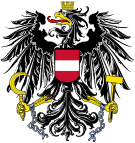1953 Austrian legislative election
1953 Austrian legislative election
First party
Second party
Leader
Leopold Figl
Adolf Schärf
Party
ÖVP
SPÖ
Last election
44.03%, 77 seats
38.71%, 67 seats
Seats won
74
73
Seat change
Popular vote
1,781,777
1,818,517
Percentage
41.26%
42.11%
Swing
pp
pp
Third party
Fourth party
Leader
Herbert Kraus
Johann Koplenig
Party
VdU
KPÖ
Leader since
25 March 1949
Last election
11.67%, 16 seats
5.08%, 5 seats
Seats won
14
4
Seat change
Popular vote
472,866
228,159
Percentage
10.95%
5.28%
Swing
pp
pp
Results of the election, showing seats won by constituency and nationwide. Constituencies are shaded according to the first-place party. Results of the election by states
Parliamentary elections were held in Austria on 22 February 1953. They were the elections in which the Socialist Party received the most votes since 1920. However, the Austrian People's Party won the most seats. The grand coalition between the two parties was continued with Julius Raab replacing Leopold Figl as Chancellor of Austria , who had had to resign after facing criticism from his own party, and Adolf Schärf of the Socialist Party remaining Vice Chancellor .[ 1] [ 2]
Results
Party Votes % Seats +/– Socialist Party of Austria 1,818,517 42.11 73 +6 Austrian People's Party 1,781,777 41.26 74 –3 Electoral Party of Independents 472,866 10.95 14 –2 Austrian People's Opposition 228,159 5.28 4 –1 Bipartisan Agreement of the Centre 5,809 0.13 0 New Christian Democratic Party 3,668 0.08 0 New Christian Social Party and Non-Party Personalities 3,029 0.07 0 New Free Democrats 2,573 0.06 0 New Association of Austrian Monarchists 1,210 0.03 0 New Austrian National Republicans and Independents 1,054 0.02 0 New Austrian Patriotic Party 26 0.00 0 0 Total 4,318,688 100.00 165 0 Valid votes 4,318,688 98.25 Invalid/blank votes 76,831 1.75 Total votes 4,395,519 100.00 Registered voters/turnout 4,586,870 95.83 Source: Nohlen & Stöver[ 3]
Results by state
References
The article is a derivative under the Creative Commons Attribution-ShareAlike License .
A link to the original article can be found here and attribution parties here
By using this site, you agree to the Terms of Use . Gpedia ® is a registered trademark of the Cyberajah Pty Ltd








